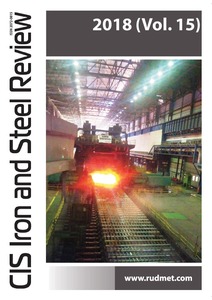Показать сокращенную информацию
DESTRUCTION MECHANISM OF CASTING GRAPHITE IN MECHANICAL ACTIVATION
| Автор | Илларионов, И. Е. | |
| Автор | Гильманшина, Т. Р. | |
| Автор | Ковалева, А. А. | |
| Автор | Ковтун, О. Н. | |
| Автор | Братухина, Н. А. | |
| Дата внесения | 2019-07-01T07:30:18Z | |
| Дата, когда ресурс стал доступен | 2019-07-01T07:30:18Z | |
| Дата публикации | 2018-06 | |
| Библиографическое описание | Илларионов, И. Е. DESTRUCTION MECHANISM OF CASTING GRAPHITE IN MECHANICAL ACTIVATION [Текст] / И. Е. Илларионов, Т. Р. Гильманшина, А. А. Ковалева, О. Н. Ковтун, Н. А. Братухина // CIS Iron and Steel Review. — 2018. — № 15. — С. 15-17 | |
| ISSN | 20720815 | |
| URI (для ссылок/цитирований) | http://www.rudmet.ru/catalog/journals/10/1737/ | |
| URI (для ссылок/цитирований) | https://elib.sfu-kras.ru/handle/2311/111538 | |
| Описание | Текст статьи не публикуется в открытом доступе в соответствии с политикой журнала. | |
| Аннотация | Development of the technologies allowing to improve the quality of initial materials is considered as the actual problem of casting and foundry production at present time. This tendency is connected with working and depletion of existing and operating deposits. Natural graphites are subjected to crushing, comminution, concentration and other operations during their preparation. Each of these operations is realized using special equipment, and their transition to the higher technological level requires additional expenses. Thereby, mechanical activation seems to be the most prospective method that does not need to include additional equipment in the technological chain of materials preparation. This process is accompanied by varying of crystal lattice energy in the processing material and is connected with forming of different structural defects (such as dislocations and vacancies), leading to forming of the new separation surfaces. The energy is reserved in such way and then it is spent for strengthening of chemical and physical-mechanical reactions during consequent fabrication of products (including non-stick coatings) on the base of activated materials, and it was proved convincing in the works. Many investigations in this field have examined only varying of parameters depending on activation time, without any discussion about the destruction mechanism of the particles. This work was aimed on examination of the destruction mechanism of natural graphite during mechanical activation from the point of view of crystallography. Natural crystalline graphite from Zavalyevskoe deposit has been chosen for investigations. The destruction mechanism has been studied on large oval graphite plates with maximal diameter 1.5 mm. Graphite activation was realized in the AGO-2 mill of planetary-centrifugal type. The activation procedures are discussed in the paper. Metallographic analysis via transmission electronic microscope UEVM-100K was used for determination of the mechanism of crack origination in graphite particles. Natural crystalline graphite from Zavalyevskoe deposit containing of oval graphite plates with maximal diameter 1.5 mm and small particles (about 10%) with more complicated and elongated form has been chosen for investigations. Size and total surface of particles, their distribution on fractions has been determined by the method of light laser screening in Novosibirsk institute of solid state chemistry and mechanochemistry on PRO-7000 unit. The form and micro-shape of particles has been determined using transmission electronic microscope UEVM-100K. It was established that destruction of particles during graphite mechanical activation occurs via the mechanism similar to destruction during usual forging. At the same time it was noted that two main types of plastic deformation (slipping and twinning) are observed in mechanical activation owing to strong deformation of graphite crystals under the effect of balls. Fracture planes coincide with slipping planes, while fracture is caused by the defined stress value perpendicular to the fracture surface | |
| Тема | graphite | |
| Тема | mechanical actication | |
| Тема | destruction | |
| Тема | plastic deformation | |
| Тема | slipping plane | |
| Тема | twinning | |
| Тема | cast iron | |
| Тема | burn-in | |
| Тема | non-stick coating | |
| Название | DESTRUCTION MECHANISM OF CASTING GRAPHITE IN MECHANICAL ACTIVATION | |
| Тип | Journal Article | |
| Тип | Published Journal Article | |
| Страницы | 15-17 | |
| ГРНТИ | 55.15.19 | |
| Дата обновления | 2019-07-01T07:30:18Z | |
| DOI | 10.17580/cisisr.2018.01.03 | |
| Институт | Институт цветных металлов и материаловедения | |
| Подразделение | Кафедра фундаментального естественнонаучного образования | |
| Подразделение | Кафедра общей металлургии | |
| Подразделение | Кафедра металловедения и термической обработки металлов им. В. С. Биронта | |
| Подразделение | Кафедра инженерного бакалавриата CDIO | |
| Журнал | CIS Iron and Steel Review | |
| Квартиль журнала в Scopus | Q1 |

